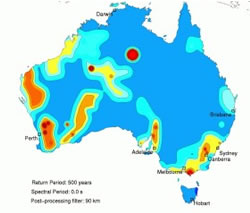 Geoscience Australia (GA) has issued the latest update to the National Seismic Hazard Assessment (NSHA) for Australia, revealing Western Australia, Victoria and the ACT the most likely areas to suffer an earthquake.
Geoscience Australia (GA) has issued the latest update to the National Seismic Hazard Assessment (NSHA) for Australia, revealing Western Australia, Victoria and the ACT the most likely areas to suffer an earthquake.
It is the first update to the NSHA since 2012.
Senior Seismologist at GA, Trevor Allen said although Australia is not usually associated with large, damaging earthquakes, on average 100 earthquakes of magnitude 3.0 or larger are detected across the country each year.
“It’s impossible to accurately predict exactly when and where an earthquake will occur but the history of earthquake activity in a region can tell us a lot about its potential risk for future earthquakes,” Dr Allen said.
He said regularly updating the NSHA helped Australian communities prepare for future earthquake events.
“The NSHA provides key information to Government Agencies and regulators, so buildings and infrastructure design standards can be updated to mitigate the impact of strong earthquake ground shaking,” Dr Allen said.
“The Wheatbelt in Western Australia has high rates of historical seismicity, including the 1968 magnitude 6.5 earthquake near Meckering. We estimate Wheatbelt communities could expect to experience a magnitude 5.0 earthquake every 10 to 25 years.”
He said some of Australia’s most active faults are located in Gippsland’s Latrobe Valley and Strzelecki Ranges, which have the potential to host a very large earthquake and contribute to elevated seismic hazard estimates at longer timescales.
“The Gippsland region has relatively high rates of natural seismicity and we estimate a magnitude 5.0 earthquake in the region every 25 to 50 years,” Dr Allen said.
“Outside of regional Australia, Canberra is now the capital city with the highest estimated seismic hazard, Dr Allen said.
“This is due to its proximity to both the Lake George and Murrumbidgee faults, which contribute to its long-term hazard forecast and its moderate levels of historical seismicity,” he said.










